Common Diseases of Parrots
If you have read As Sick as a Parrot, it should be obvious that a large proportion of disease problems in parrots result from dietary and environmental influences. Infectious conditions are important, and will be covered in this section, together with important steps to take in the prevention, control and elimination of disease from your birds. This is no veterinary text book, so will not catalogue every disease encountered. It will just summarise some of those most likely to be met by the average parrot-keeper.
DIET
This is covered in more detail here Parrot Nutrition. Most disease problems are the result of long-term dietary imbalance. Minor irregularities may show as long-term poor growth and development, poor quality plumage or breeding performance. More marked changes will manifest as specific disease entities.
Deficiencies
By far the most common important food items lacking in parrots’ diets are vitamin A and Calcium. Both these substances are found in low quantity in the standard seed-based ‘parrot-mix’, so birds that select this diet – or are given nothing else – will inevitably develop problems in time. Hypovitaminosis-A will have damaging effects on the lining membranes of mouth, nose and throat, as well as the kidneys. Gradually these membranes become thickened and secondarily infected, showing as enlarged, blocked nostrils, ‘abscesses’ in the tongue or facial sinuses, or kidney failure. The caseous (cheesy) accumulations will need to be removed, and the parrot’s diet improved and supplemented with vitamin A. For more details, see Hypovitaminosis-A


Caseous mass in front of eye African grey parrot, resulting from long term deficiency of vitamin A
Left -as presented; Right - after incision, exposing cheesy mass
Hypocalcaemia can have many profound effects depending on its severity and the stage of life at which it develops. Breeding parrots may have no eggs, or soft-shelled eggs; hens that do produce eggs may become egg-bound as their muscles weaken easily; growing chicks may have soft, deformed bones (‘rickets’). Adult birds will have muscle tremors or weakness, finding it difficult to hang on to their perches. More severely affected birds will have epileptiform attacks or ‘fits’, lasting 2 or 3 minutes. The bird will fall suddenly to the floor, squawking and flapping frantically. Gradually it will relax and calm down, remaining limp and motionless, before slowly regaining consciousness, finding its feet, and climbing back up the cage. The patient may break claws or feathers in the process, and will often bruise the facial skin or eye ridges. African Grey and Eclectus parrots are most frequently affected: they seem either to have a greater need for calcium than other species, or are less efficient at metabolising it. Of the panic ‘phone calls I get from anxious owners or veterinarians describing an African grey as “falling from its perch” or “having a fit”, 95% turn out to be caused by calcium deficiency problems, and respond rapidly to therapy with calcium. This is all covered in more detail in its own article Hypocalcaemia
Excess
Many captive parrots eat far too much food, resulting in an excessive intake of carbohydrates and fats. If human junk food is a part of this intake, the problem will be made much worse. Affected birds will appear rotund, with yellow fat deposits showing through their thin skin. This is just the tip of the iceberg – similar accumulations will occur inside the body around the internal organs, resulting in pressure and malfunction, as well as difficulty in breathing because of reduced capacity of the air sacs. The liver and kidneys particularly will become infiltrated with fat cells, seriously compromising their function. This is in turn often reflected in overgrowth and flaking of the beak, or haemorrhage within its substance. Major blood vessels will become thickened with fat in their walls, just as they do in humans, leading to increase in blood pressure, reduced exercise ability, breathlessness, and heart failure. Increased bodyweight will put extra strain on joints and ligaments. The prime culprits are Amazon Parrots, Roseate Cockatoos, and Budgerigars. These are all species that will eat all day if allowed, and often select the high-fat food items. Prolonged fat-deposition – especially in Budgerigars – will often lead to the formation of fatty tumours, or lipomata.
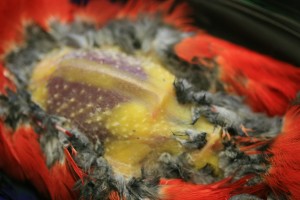
Yellow excess fat visible under the skin of a Pennant Parakeet
TOXINS
Poisons may be ingested (eaten) or inhaled. Swallowed agents include Avocado (see Parrot Nutrition), causing gastro-enteritis and nervous signs; and heavy metals such as zinc and lead (see Poisons & Parrots) causing haemorrhagic enteritis and nervous signs. The inquisitive nature of most parrots means that they will often nibble at things that should not concern them, and make themselves ill as a result. Continual vigilance is required on the part of the owner to ensure that household items like electric cables, small metal objects, or other potentially dangerous items are kept out of the bird’s reach. Toxic houseplants or outdoor vegetation accessible to aviary birds may also be a problem.
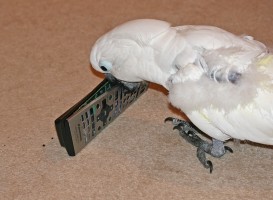
Cockatoo destroying a TV remote controller - not a safe toy!
The unique anatomy of the parrot’s respiratory system makes it very sensitive to inhaled gases. Carbon monoxide, coal gas, cigarette or bonfire smoke, aerosol sprays, and paint fumes will all cause problems to birds. (See Toxic Fumes and No Smoking around Birds!) There may be transient coughing or choking, ‘asthmatic’ attacks, or chronic respiratory disease with prolonged exposure. Perhaps the most toxic and dramatic are the fumes given off by over-heated non-stick pan linings (like Teflon®) or cooking oil. Such occurrences will kill a parrot within minutes.
TUMOURS
Many types of tumour are found in parrots, but budgerigars are perhaps the most susceptible. These may be internal, and would include growths in the liver, ovary or testes, or occasionally other organs. Tumours affecting the gonads will often manifest as lameness, as well as a swollen abdomen. Alternatively they may be external, affecting the skin, feathers, or preen gland. Most skin tumours are benign accumulations of fat (lipomata), or cholesterol (xanthomata), but others may be aggressive skin cancers or localised nodular fibrous tumours. Others may be virus-linked (papillomata – see below).
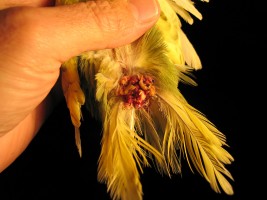
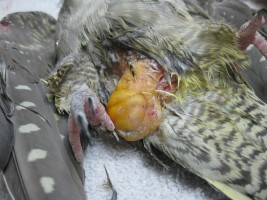
Left - tumour of preen gland in a budgerigar; Right - xanthoma (cholesterol tumour) in a cockatiel
VIRUS DISEASES
There are several of these minute, infectious, intra-cellular organisms that will cause specific diseases in parrots. Some that are found in other birds, like Avian Influenza are infrequently encountered in parrots.
Pox virus is occasionally seen in macaws, producing crusty lesions on the facial skin. Adenoviruses generally result in liver disease (hepatitis), and particularly affect Lovebirds. Paramyxovirus will affect the nervous systems of small grass parakeets (Neophema species), manifesting as head tilt and circling, with loss of balance. This virus occurs commonly in pigeons and doves, and these birds therefore may be a source of infection to parakeets. A vaccine produced to protect pigeons has been used with some success in vulnerable and valuable flocks of parakeets.
In poultry, many tumours are virus-induced, and it is quite likely that similar viruses of the leucosis group are responsible for tumours in budgerigars and cockatiels. Papillomavirus certainly produces wart-like growths in the cloaca and oral cavity.
A common herpes virus causes an acute, rapidly fatal, hepatitis in parrots, and is known as Pacheco’s Disease. This is most frequently encountered in recently imported birds in quarantine. It will spread rapidly and will wipe out a high percentage of the group in a few days.
Polyomavirus generally afflicts young parrots, and will result in sudden death, with pale skin and pin-point haemorrhages visible in the skin and around abdominal organs. Any birds that do survive (especially budgerigars) generally develop abnormal stunted feathering.
Circovirus is the cause of the highly unpleasant Psittacine Beak and Feather Disease (PBFD). This virus attacks young growing feather and beak tissue in fledgling birds, as well as damaging their immune system, so they have no resistance to other diseases. In budgerigars it is known as French Moult, and although most infected birds will die, some will survive but with damaged wing and tail feathers, so they can never fly and are hence known as runners. In most other parrots, infection is almost invariably fatal. The course of the disease varies with the age at infection and the infective dose of virus. Very young chicks will die quickly, often dropping feathers by the handful first. Older birds will develop characteristic feather deformities or discolourations – white in black birds like the Vasa parrot or pink in African greys. See also Psittacine Beak & Feather Disease
Avian Bornavirus is responsible for another devastating disease with a prolonged incubation period – Macaw Wasting Disease (so-called because it was first identified commonly in macaws), or Proventricular Dilatation Disease (PDD) or Proventricular Dilatation Syndrome (PDS). This virus is similar in its effects to Key-Gaskell Syndrome in cats or Grass Sickness in horses. Initial infection causes mild transient diarrhoea, from which most individuals recover. In a small percentage, there is damage to the nerves controlling the stomach, so that this organ becomes stretched, thin-walled and bloated. Digestive efficiency is impaired, so affected birds will eat well but lose weight, commonly vomit, and will pass undigested food items (especially seed kernels) in their droppings. Some birds will also show nervous signs such as tremors or inco-ordination. Like PBFD, the incubation period can be many months, making the source of infection difficult to define. It is also currently incurable, although isolated pet birds may be maintained by feeding soft foods and giving non-steroidal anti-inflammatory drugs (NSAIDs).
All these viral diseases have no specific treatments, since antibiotics will have no effect. Thus their control depends on vaccination (where possible, and currently such availability is very limited); hygiene and disinfection; and quarantine. It is important never to mix newly-acquired birds with existing stock immediately. They should be kept in isolation for a period of quarantine to allow dormant infections to show themselves. This period should be from 10 – 30 days, the longer the better. Most infectious agents will show up in this time, but as mentioned with PBFD and PDD, some viruses will incubate for many months. However, parrots can be tested during the quarantine period for the presence of these viruses. Such control measures apply equally to other infectious diseases.
PSITTACOSIS
Psittacosis is a common and potentially serious disease occurring in both the birds that we keep and the humans that keep them, and is described in far more detail in its own section - Psittacosis
BACTERIAL DISEASES
Because of the ‘open’ nature of a parrot’s anatomy, with no muscular diaphragm to separate the chest cavity from the abdomen, and free communication between the air sac system and the hollow bones, most introduced infectious organisms may start in one organ like the lung or the stomach, but will rapidly spread around the body to produce a septicaemia. The list of possible bacteria is long, and precise identification would depend upon laboratory culture and analysis. Such tests can include antibiotic sensitivity, revealing which antibacterial drug should theoretically kill the organism. The choice will be tempered by cost, availability, possible side-effects, and the practicalities of its administration to the patient. Drugs given in drinking water are often not taken in sufficient dose by the bird; palatable in-food medications are few and far between; while the daily administration of drops, tablets, or injections is stressful for the parrot and the owner.
Common bacteria include the enteric ‘food-poisoning’ organisms Salmonella and E. coli; Klebsiella, Yersinia, Mycobacteria (tuberculosis) and many others. Because of the range of organs involved, infected birds will generally show the generic ‘sick parrot’ appearance, being fluffed up, subdued, inappetant, and with loose, discoloured droppings. (See also Bacterial Cultures for Disease Diagnosis)
FUNGAL DISEASES
Yeast organisms like Candida albicans cause disease of the digestive system, often following antibiotic usage or damage to the immune system. Hand-reared chicks are commonly affected, with thrush appearing as yellow plaques in the mouth; or infections of the crop, with thickenings of the lining with creamy yellow-deposits. Older parrots may have smelly, pasty diarrhoea, and stained impression smears of their droppings will show large quantities of yeast organisms.
Aspergillosis is caused by the inhalation of fungal spores that grow inside the bird as a fungal plaque in the lungs or on the air sacs. Such spores are present continually in the air we breathe: small numbers of spores are eliminated by protective white blood cells in the body. Active infection arises either when large quantities are inhaled, such as when mould grows on food or droppings left in the cage or aviary, or the parrot cracks open a stale nut; or if the bird’s immune system is weakened by poor diet or virus infection. It is very common to find Aspergillosis in young African grey parrots: many of these birds turn out to be infected with PBFD virus.
The fungus causes disease in two ways. Firstly the physical presence of the mould growth will affect the bird’s breathing. Fungal colonies developing at the base of the trachea (windpipe) result in an acute, choking problem, with rapid death without emergency treatment. Growth in the lungs will lead to pneumonia, while that in the air-sacs will cause more insidious, gradual breathing problems. Meanwhile, the fungal colony releases a toxin in to the blood stream that attacks the liver, causing death by toxic hepatitis.
Two articles were published in the Parrot Society magazine in 2021, describing this unpleasant disease and its devastating effects in more detail. The first describes the science of the infection and its signs and effects - Aspergillosis 1 - The Science - while the second article describes the emotional effects on the owners of affected birds - Aspergillosis 2 - The Emotion
Megabacterium (Macrorhabdus ornithogaster) is an organism something between a bacterium and a fungus, which is treated with a combination of antibiotics and anti-fungal drugs. Its most common manifestation is as a chronic digestive disease in budgerigars, with vomiting and weight loss.
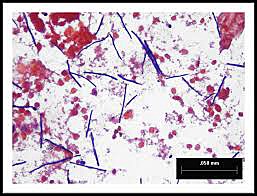
Macrorhabdus ornithogaster (Megabacteria) staining dark purple in a faecal sample
PARASITES
These may be external or internal, and are generally larger organisms living on body tissues of their host.
Internal Parasites include protozoa and coccidia, although these tend to be less of a problem in parrots than in poultry and other bird species. The exception is Trichomonas, which causes canker in pigeons or frounce in birds of prey. This organism will also frequently infect budgerigars, resulting in chronic vomiting and weight loss, similar to megabacteriosis.
Tapeworms are seen occasionally in recently imported African grey parrots or cockatoos, and will appear protruding from the vent as a creamy-grey wriggly ribbon 2 – 3 mm across.
Roundworms are far more common, especially in ground-feeding birds like grass parakeets and some cockatoos. They may be passed in the droppings, and appear as 2 – 3 cm long, pointed at both ends.
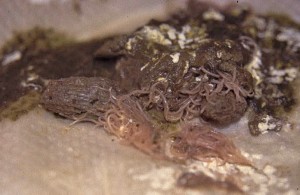
Ascarid roundworms in cockatoo droppings
External Parasites include ticks, lice and mites. Ticks live for much of the year resting in vegetation, but will climb to find a suitable host when they require a meal of blood. They are found particularly in areas where there are sheep, rabbits, or hedgehogs, and most vulnerable are parrots in outside aviaries with over-hanging plants. The ticks will attach to the unwary bird by way of their sharp, barbed mouthparts and suck blood over the next few days, swelling in size as they do. Once sated, they will drop off, but they inject an anti-coagulant into the puncture site. Some birds will react to this substance, and will be found suddenly dead with no previous signs of illness. The tick may or may not still be attached. Control of this problem depends on the removal of overgrown vegetation from around the flight.
Lice and Mites living on the feathers and skin are far less common in parrots than they are in species like canaries, poultry and pigeons. However, quill mites that live within the feather may be a cause of some feather-plucking problems. The most common external parasite found in parrots is the scaly face/leg mite Cnemidocoptes, and this is most frequently encountered in budgerigars. This is similar to the mange mites of cats, dogs and foxes, and burrows in to the skin, resulting in crusty thickened skin in affected areas. Historic treatments include the use of liquid paraffin or petroleum jelly, which will have the effect of suffocating the mites; or benzyl benzoate applications, which gradually will kill the parasite. However, these treatments require prolonged, repeated applications to achieve success. Current medication is by application of the parasiticide ivermectin. This is absorbed through the bird’s skin, and kills the mite via the bloodstream. Generally two application 10 – 14 days apart will be successful, although in severe cases a third may be required. The infestation appears not to be highly contagious: only a few individuals in a flock may show signs. There appears to be a need for immuno-suppression in the bird before the mite can multiply sufficiently to show clinical disease.
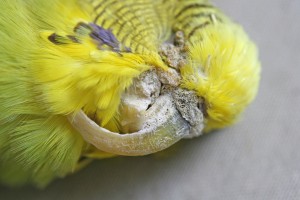
Severe Scaly Face infestation in a budgerigar
FIRST AID CARE
It should by now be obvious that there are many disease conditions that can potentially affect your birds. Precise diagnosis and specific treatment is the province of an experienced avian veterinarian, but several commonsense precautions may be taken to avoid such problems. These include quarantining new arrivals, as mentioned above, and not mixing new birds immediately with existing stock. Good hygiene and regular disinfection of food and water bowls, perches, nest boxes, toys and cages are essential. The control of vermin and the secure storage of good-quality food in air-tight containers are important. Selection of sound, healthy stock in the first place is obviously wise; and the feeding of a top quality, well-balanced diet, suited to the species is paramount. Finally, regular observation of your birds, to identify subtle changes in their normal behaviour and attitude, will enable you to spot problems before they become too advanced.
If you do consider that you have a sick bird, then there are three useful things to do. The first is isolation. Separate the bird from any companions, and bring it in to a small indoor cage. This will allow you more closely to observe it and monitor its progress; more easily to administer any medication that may be required; hopefully to avoid further spread of the disease should it be contagious; and to avoid bullying of the sick birds other members of its group.
Secondly warmth. Birds have a high metabolic rate, and will expend a lot of energy just to maintain their body temperature. Supplying external warmth will aid the bird’s recovery by enabling it to divert energy to getting better. This may simply mean bringing an aviary bird indoors. Alternatively, use a heat pad, a hot-water bottle, an airing cupboard, or place the cage near a radiator. It may be worth investing in a hospital cage, or an infra-red heat lamp.
The third important home therapy is fluids. Sick birds will dehydrate rapidly, especially if they have vomiting or diarrhoea. Encouraging their fluid intake by sweetening their drinking water with honey, sugar, glucose, or fruit juices will prove invaluable. Better still are proprietary oral electrolyte solutions. If the parrot will not drink voluntarily, these must be administered by spoon, dropper, syringe, or crop tube.
Resist the temptation to reach for the old pot of antibiotic powder at the back of the cupboard, or worse still use some prescribed for a friend’s birds! As I hope by now I have made clear, antibiotics are effective only against bacterial infections, which account for about 25% of sick birds. You will do far better to give a probiotic, as well as the fluids and electrolytes, until you have obtained a proper diagnosis. This will have the effect of boosting your bird’s immune system and aiding its digestion, while it recovers.
See also When should I take my bird to a Vet?
This article was adapted, with permission, from "Keeping Parrots - Understanding Their Care & Breeding" by Alan K Jones BVetMed MRCVS
The Crowood Press, ISBN 978 1 84797 263 7 (2011)
Posted by AKJ October 2020
